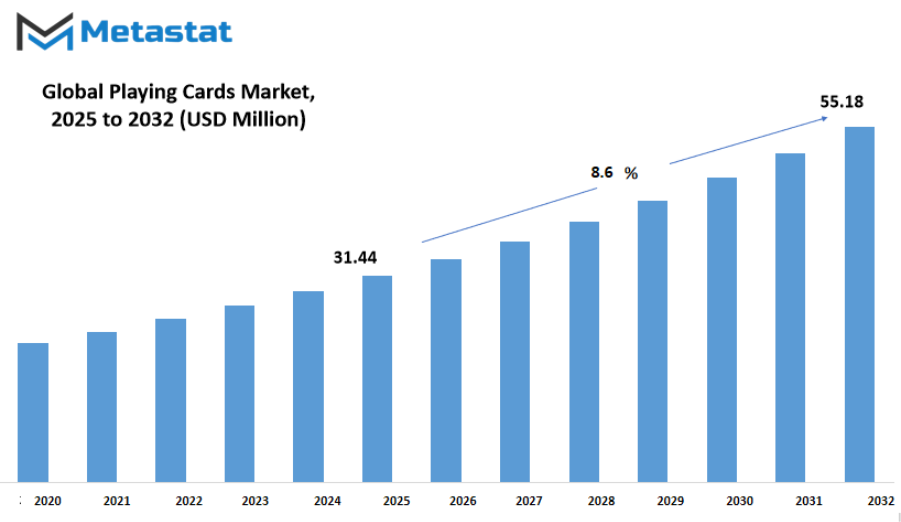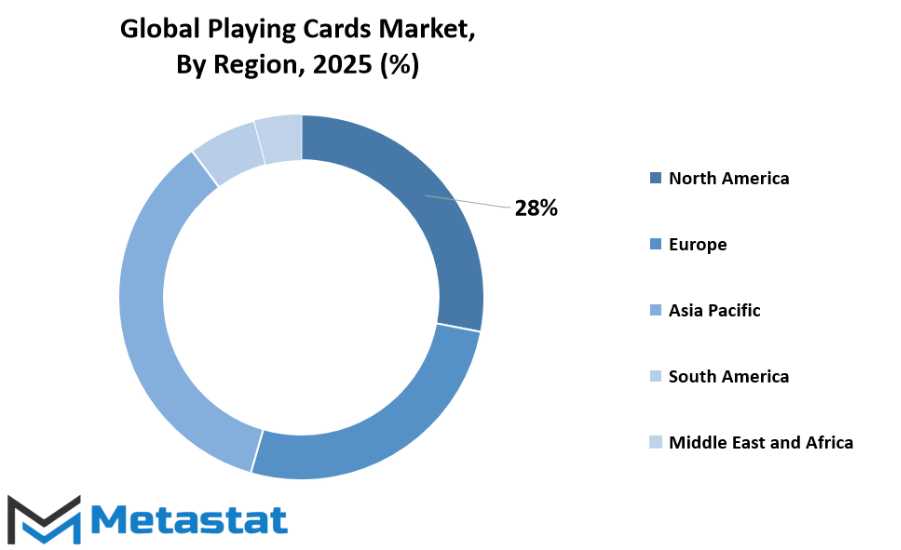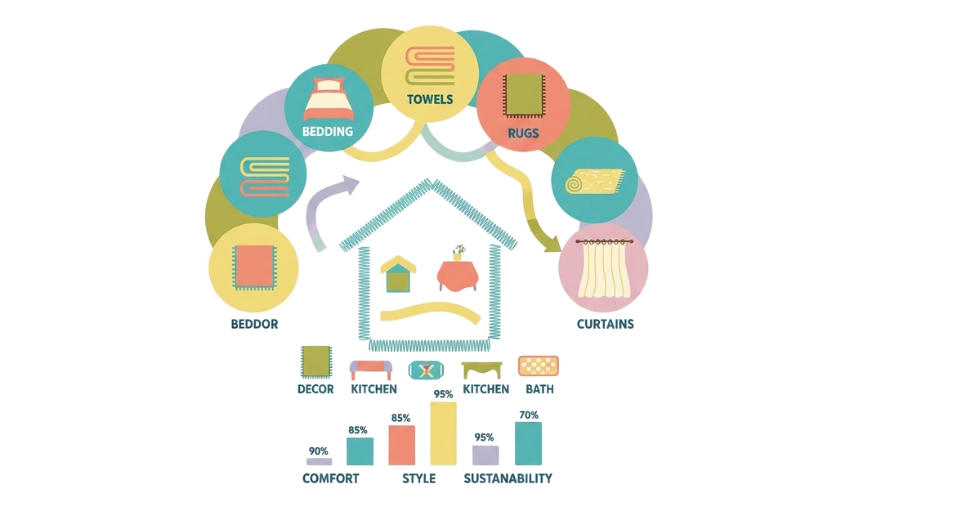MARKET OVERVIEW
The global playing cards market will remain unique to both cultural heritage and contemporary entertainment habits. Cards have never been relegated to one function; they have been family reunions, work tournaments, street play, and even art collectibles. Due to this multiple function, the industry will not only remain current but will also evolve into new media that are compatible with altered social behavior. The global playing cards market will no longer be seen merely as a provider of decks but as a changing platform incorporating history, imagination, and innovation. The industry has long enjoyed a strange affinity with its audience.
Playing cards have, on one hand, borne centuries of heritage, evidenced by designs based on particular regions and traditions. Meanwhile, the same set has been redirected to various games and even used for educational aids, magic shows, and virtual interpretations. The global playing cards market will continue redefining itself in these multiple identities so that the product is never seen as old-fashioned even though it is one of the oldest leisure tools known to humans on the entire planet. Future innovations will most probably feature an increased interaction between physical boards and virtual environments. Traditionalists will still cherish the tangible sensation of cards, the shuffle, and the physicality that comes with sitting around a table.
But younger audiences, accustomed to interactive technology, will require innovative crossovers. The global playing cards market will thus test methods of linking printed decks with apps, online tournaments, and virtual experiences, closing the gap between physical products and digital platforms. Aside from entertainment, the industry will extend itself to education, therapy, and design. Cards have long had visual stories to tell, and their iconography will find its way to classrooms, counseling offices, and branding sessions. The global market will outreach into industries that are not commonly related to leisure, demonstrating its versatility in places where communication and visual narration are as important as play. Cultural identity will be at the forefront of how this market moves. Decks from Europe, India, or Japan will still boast local craftsmanship, and generations to come will be looking for limited series that pay homage to cultural narratives.
The global playing cards market will find itself not merely as a business but as a keeper of traditions, with designers and artists utilizing cards as small, portable paintings. In that way, the industry will be a bridge between business and culture, offering not merely a game but also an item of history and artistry. As lifestyles evolve, cards will remain intact because they are light, convenient, and infinitely adaptable. Even when new ways of entertainment become the norm, the Global Playing Cards industry will evolve by reminding people of the enduring quality of card play while assimilating innovation where needed. This blend of tradition and innovation will characterize the future of the industry, and it will continue to resonate with various audiences around the world.
Global playing cards market is estimated to reach $55.18 Million by 2032; growing at a CAGR of 8.6% from 2025 to 2032.

GROWTH FACTORS
The global playing cards market has been witnessing steady growth in recent years, driven by the growing popularity of card games and recreational activities across various age groups. Card games have remained a popular source of entertainment, offering both social interaction and mental stimulation. This trend is expected to continue as more people seek engaging offline activities that provide relaxation and enjoyment. In addition, the rising interest in competitive and casual gaming has encouraged the demand for traditional playing cards, which continue to hold value despite the digitalization of many forms of entertainment.
Another key factor contributing to the growth of the global market is the increasing demand from casinos and online gaming platforms. Casinos rely heavily on high-quality playing cards for a smooth gaming experience, while online platforms often use them to simulate real-life card games for players. The consistent requirement from these sectors ensures a stable demand, which is expected to support market expansion in the coming years. The reputation and reliability of established brands in supplying premium cards further strengthen the position of the market.
However, the market faces challenges that may slow its growth. The rise of digital gaming has diverted some consumers away from physical card products. With many people turning to mobile and online games for convenience, the need for traditional cards may see slower growth in certain segments. Additionally, the presence of counterfeit and low-quality products poses a threat to brand reputation and consumer trust. These products can affect sales of genuine cards and limit the expansion of new or smaller brands in the market.
Despite these challenges, the global market is poised to benefit from emerging trends, particularly the rising popularity of customized and collectible cards. These products appeal to enthusiasts and collectors who value uniqueness and personalization, offering an exciting avenue for market innovation. Companies introducing limited editions, themed decks, or personalized designs will likely attract attention and encourage higher consumer spending. Over the next few years, such innovative offerings are expected to create lucrative opportunities and drive further market growth, especially among niche audiences who value creativity and exclusivity in their collections.
In conclusion, the global playing cards market will continue to grow due to strong demand from both recreational players and commercial sectors. While challenges such as digital competition and counterfeit products may pose obstacles, the increasing popularity of customized and collectible cards is likely to provide new pathways for expansion. The market is positioned to adapt and evolve, maintaining its relevance in a changing entertainment landscape.
MARKET SEGMENTATION
By Type
The global playing cards market is expected to witness substantial growth over the coming years, driven by rising interest in both traditional and modern forms of card games. The market will see increasing demand from individuals and communities seeking leisure activities that provide entertainment and social interaction. As lifestyles continue to shift towards more home-based and casual recreational activities, the global market will benefit from a steady increase in consumption. Manufacturers are likely to introduce innovative designs and packaging to attract a diverse audience, further enhancing market expansion.
By Type, the global playing cards market is further segmented into Paper Playing Cards and Plastic Playing Cards. Paper Playing Cards will continue to maintain a significant share due to their affordability and ease of production. They are preferred for casual gameplay, promotional purposes, and collectible editions, which makes them a popular choice across different age groups and regions. On the other hand, Plastic Playing Cards are expected to see accelerated growth because of their durability, resistance to wear, and higher quality feel. These cards will become increasingly popular in professional gaming and among enthusiasts who prioritize longevity and premium experience. The shift towards Plastic Playing Cards indicates a future where the market will cater to consumers seeking products that last longer and provide a better tactile experience.
Innovation in design, material, and packaging will play a critical role in shaping the future of the global market. Companies will explore environmentally friendly materials and advanced printing technologies to appeal to a wider audience while reducing production costs. Limited edition releases and collaborations with popular brands may become common strategies to attract collectors and casual players alike. Additionally, the integration of augmented reality and digital elements into traditional playing cards could create a unique hybrid experience, merging physical gameplay with interactive digital features.
Regional trends will also influence market growth. Markets in developing countries are expected to expand due to rising disposable incomes and growing interest in leisure activities. Simultaneously, established markets will see steady demand driven by enthusiasts and collectors. The combination of innovative product development, strategic marketing, and expanding consumer interest will ensure that the global playing cards market remains vibrant and continues to evolve, creating opportunities for manufacturers and suppliers to introduce products that meet future consumer expectations.
By Sales Channel
The global playing cards market has witnessed significant transformations in recent years, shaped by changing consumer preferences and technological progress. Traditional offline retail has long been the foundation for card sales, offering physical stores where customers can directly examine products. This channel continues to hold importance as it provides a tangible experience, allowing buyers to interact with different card designs and brands. In the coming years, offline retail is expected to adapt by integrating technology such as augmented reality displays and interactive in-store demonstrations, enhancing engagement and providing a more personalized shopping experience.
Online and e-commerce platforms have become increasingly influential in the global playing cards market, especially as consumers seek convenience and variety. E-commerce will continue to grow, supported by global connectivity and faster delivery networks. Digital platforms allow access to a wider range of products, including limited editions or specialty decks, which may not always be available in physical stores. The future will likely see online sales expanding further, with innovations like virtual try-before-you-buy experiences and AI-driven recommendations improving customer satisfaction and driving repeat purchases.
Casino-specific distribution remains a crucial segment within the global playing cards market, catering to professional and entertainment-focused environments. Casinos require bulk orders, high-quality cards, and specialized designs that meet strict standards for durability and performance. This channel will maintain a steady demand as gaming industries expand in emerging markets and as casinos seek to enhance user experiences with custom or premium decks. Technology integration, such as RFID-enabled cards for automated tracking and gameplay analytics, may shape the future of this segment, providing efficiency and improved security.
Direct B2B sales also play a growing role in the global playing cards market, targeting businesses such as hospitality chains, event organizers, and promotional product companies. B2B transactions offer opportunities for bulk orders and custom designs that meet specific branding needs. In the years ahead, this channel is expected to benefit from streamlined procurement processes, digital catalogs, and personalized service options, making it easier for businesses to source high-quality playing cards efficiently.
Overall, the global playing cards market will continue to expand through a combination of traditional and modern distribution channels. Offline retail, online platforms, casino-specific distribution, and direct B2B sales will each contribute to market growth, driven by innovation, technology, and changing consumer demands. As the market evolves, adaptability and the ability to meet diverse customer needs will determine the success of players in this industry, ensuring that the appeal of playing cards remains strong for years to come.
|
Forecast Period |
2025-2032 |
|
Market Size in 2025 |
$31.44 million |
|
Market Size by 2032 |
$55.18 Million |
|
Growth Rate from 2025 to 2032 |
8.6% |
|
Base Year |
2024 |
|
Regions Covered |
North America, Europe, Asia-Pacific Green, South America, Middle East & Africa |
REGIONAL ANALYSIS
The global playing cards market is expected to experience significant growth in the coming years, driven by a combination of technological advancements, rising consumer interest, and expanding regional opportunities. Based on geography, the market is divided into North America, Europe, Asia-Pacific, South America, and the Middle East & Africa. North America includes the U.S., Canada, and Mexico, with the U.S. taking the lead due to strong consumer engagement and innovative product launches. Canada and Mexico are projected to follow with steady growth, supported by increasing adoption of digital gaming platforms and traditional card games alike.
Europe covers the UK, Germany, France, Italy, and the Rest of Europe. The UK will maintain a strong presence because of established consumer loyalty and a growing preference for collectible card products. Germany and France are anticipated to witness growth through rising recreational activities and organized card tournaments, while Italy and other European nations will gradually contribute to the market by embracing niche card gaming communities. Europe’s focus on quality production and sustainable manufacturing methods will also create new opportunities for companies seeking environmentally responsible options.
Asia-Pacific includes India, China, Japan, South Korea, and Rest of Asia-Pacific. The region will show the fastest growth, primarily due to large populations and increasing disposable income. China and India will lead expansion, as both countries are investing heavily in manufacturing infrastructure and consumer entertainment industries. Japan and South Korea will continue to drive innovation through unique designs and premium card collections. Other nations in the region are expected to adopt trends from leading markets, contributing to overall growth.
South America consists of Brazil, Argentina, and the Rest of South America. Brazil will play a key role, fueled by rising interest in recreational activities and card game events. Argentina and other South American countries are anticipated to gradually expand, creating new opportunities for local and international players.
The Middle East & Africa includes GCC Countries, Egypt, South Africa, and Rest of Middle East & Africa. GCC nations will benefit from higher consumer spending, while Egypt and South Africa will see growth from urbanization and rising interest in leisure activities. Other countries in the region are expected to adopt innovations from leading markets, supporting long-term growth.
Overall, the global playing cards market will continue to evolve with new trends, product innovations, and regional expansions. Companies that align with changing consumer preferences and technological developments will remain competitive and drive future success in the market.

COMPETITIVE PLAYERS
The global playing cards market has experienced steady growth in recent years, driven by rising demand for both traditional and specialty cards across various regions. The market will continue to witness dynamic developments as manufacturers focus on innovation, quality, and unique designs to attract diverse consumer segments. The growth is not limited to conventional card games; collectible, luxury, and limited-edition decks are gaining popularity, appealing to enthusiasts and collectors alike. Advances in printing technology and design techniques will allow companies to produce visually appealing cards with enhanced durability, further fueling market expansion.
Competitive players in the global playing cards market are increasingly adopting strategies to strengthen their positions and differentiate offerings. Companies such as ZheJiang BingWang Playing Cards Co., Ltd., Buffalo Games, Cartamundi Group, Copag, Dal Negro, DiaoYu, and Dongguan Chensheng Printing continue to invest in product development, ensuring that their decks meet changing consumer preferences. Manufacturers are expected to leverage digital marketing and e-commerce platforms to reach a broader audience, providing convenience and accessibility for buyers worldwide. As a result, traditional market boundaries will blur, enabling global players to establish a strong presence in emerging regions where demand for quality playing cards is rising.
Innovation will remain a core driver in the competitive landscape. Players like Ellusionist, Expert Playing Card Co., F-mi, Games Workshop Limited, Grey Fox Games, IELLO, Jiangsu Hicreate Entertainment Co., Ltd., Kardwell International, Kyoto Ohishi-Tengudo Corporation, Legends Playing Card Co. (LPCC), Mattel, Modiano, Naipes Heraclio Fournier, NINGBO THREE A GROUP CO., LTD., Nintendo, Piatnik, Jiangsu Santu Group, Shanghai Yaoji Playing Card Co., Ltd., Theory11, United States Playing Card Company, and Yaoji Poker are expected to launch decks featuring creative designs, premium finishes, and themed series. Collaborations and limited-edition releases will also enhance brand visibility and foster loyalty among dedicated collectors.
The future of the global playing cards market will likely involve a blend of tradition and modernity. Companies focusing on superior printing techniques, sustainable materials, and distinctive aesthetics will gain a competitive advantage. Expansion into untapped regions, combined with targeted marketing campaigns, will drive growth and encourage greater consumer engagement. As key players refine their strategies and introduce innovative products, the global playing cards market is poised to maintain steady growth while offering unique experiences that cater to enthusiasts and casual players alike.
Playing Cards Market Key Segments:
By Type
- Paper Playing Cards
- Plastic Playing Cards
By Sales Channel
- Offline Retail
- Online / E-commerce Platforms
- Casino‑specific Distribution
- Direct B2B
Key Global Playing Cards Industry Players
- ZheJiang BingWang Playing Cards Co., Ltd.
- Buffalo Games
- Cartamundi Group
- Copag
- Dal Negro
- DiaoYu
- Dongguan Chensheng Printing
- Ellusionist
- Expert Playing Card Co.
- F-mi
- Games Workshop Limited
- Grey Fox Games
- IELLO
- Jiangsu Hicreate Entertainment Co., ltd.
- Kardwell International
WHAT REPORT PROVIDES
- Full in-depth analysis of the parent Industry
- Important changes in market and its dynamics
- Segmentation details of the market
- Former, on-going, and projected market analysis in terms of volume and value
- Assessment of niche industry developments
- Market share analysis
- Key strategies of major players
- Emerging segments and regional growth potential








 US: +1 3023308252
US: +1 3023308252






